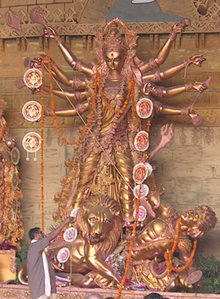| Revision as of 19:14, 2 January 2013 edit111.91.75.62 (talk)No edit summary← Previous edit | Revision as of 05:05, 19 February 2013 edit undoCydebot (talk | contribs)6,812,251 editsm Robot - Removing category Indian vegetarians per CFD at Misplaced Pages:Categories for discussion/Log/2013 February 11.Next edit → | ||
| Line 21: | Line 21: | ||
| ] | ] | ||
| ] | ] | ||
| ] | |||
Revision as of 05:05, 19 February 2013
| This article has multiple issues. Please help improve it or discuss these issues on the talk page. (Learn how and when to remove these messages)
No issues specified. Please specify issues, or remove this template. (Learn how and when to remove this message) |

A pujari or archaka is a Hindu temple priest. They are responsible for performing temple rituals, including puja and aarti, and taking care of murtis. Pujaris are mainly drawn from the Hindu Brahmin caste. Both men and women can be pujaris.
Lifestyle
All pujaris are expected to adhere to a vegetarian diet.
Throughout India, pujaris act as counselors during Hindu festivities and festivals. Pujaris have a reputation for being learned. They conduct Hindu prayer services.
In Rajput society, pujaris traditionally belonged to the priestly class in the Kshatriya community.
Other meanings
Pujari is an also Indian surname which means "priest".
See also
| Worship in Hinduism | |||||||
|---|---|---|---|---|---|---|---|
| Main topics | |||||||
| Rituals |
| ||||||
| Mantras | |||||||
| Objects | |||||||
| Materials | |||||||
| Instruments | |||||||
| Iconography | |||||||
| Places | |||||||
| Roles | |||||||
| Sacred animals | |||||||
| Sacred plants |
| ||||||
| See also | |||||||
This Hinduism-related article is a stub. You can help Misplaced Pages by expanding it. |